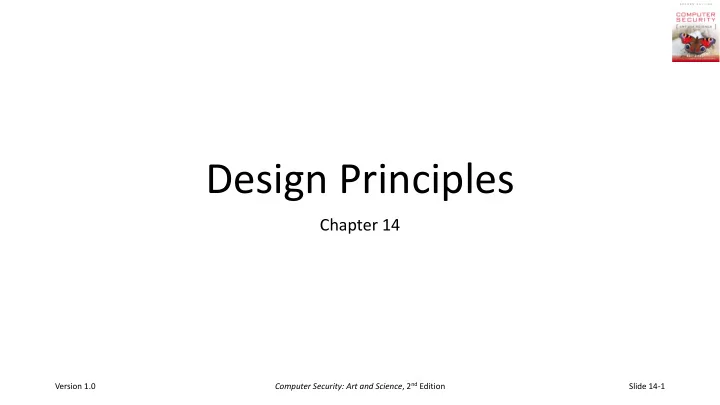

Design Principles Chapter 14 Computer Security: Art and Science , 2 nd Edition Version 1.0 Slide 14-1
Overview • Simplicity, restriction • Principles • Least Privilege • Fail-Safe Defaults • Economy of Mechanism • Complete Mediation • Open Design • Separation of Privilege • Least Common Mechanism • Least Astonishment Computer Security: Art and Science , 2 nd Edition Version 1.0 Slide 14-2
Overview • Simplicity • Less to go wrong • Fewer possible inconsistencies • Easy to understand • Restriction • Minimize access • Inhibit communication Computer Security: Art and Science , 2 nd Edition Version 1.0 Slide 14-3
Chapter 14: Design Principles • Overview • Principles • Least Privilege • Fail-Safe Defaults • Economy of Mechanism • Complete Mediation • Open Design • Separation of Privilege • Least Common Mechanism • Least Astonishment Computer Security: Art and Science , 2 nd Edition Version 1.0 Slide 14-4
Least Privilege • A subject should be given only those privileges necessary to complete its task • Function, not identity, controls • Rights added as needed, discarded after use • Minimal protection domain Computer Security: Art and Science , 2 nd Edition Version 1.0 Slide 14-5
Related: Least Authority • Principle of Least Authority (POLA) • Often considered the same as Principle of Least Privilege • Some make distinction: • Permissions control what subject can do to an object directly • Authority controls what influence a subject has over an object (directly or indirectly, through other subjects) Computer Security: Art and Science , 2 nd Edition Version 1.0 Slide 14-6
Fail-Safe Defaults • Default action is to deny access • If action fails, system as secure as when action began Computer Security: Art and Science , 2 nd Edition Version 1.0 Slide 14-7
Economy of Mechanism • Keep it as simple as possible • KISS Principle • Simpler means less can go wrong • And when errors occur, they are easier to understand and fix • Interfaces and interactions Computer Security: Art and Science , 2 nd Edition Version 1.0 Slide 14-8
Complete Mediation • Check every access • Usually done once, on first action • UNIX: access checked on open, not checked thereafter • If permissions change after, may get unauthorized access Computer Security: Art and Science , 2 nd Edition Version 1.0 Slide 14-9
Open Design • Security should not depend on secrecy of design or implementation • Popularly misunderstood to mean that source code should be public • � Security through obscurity � • Does not apply to information such as passwords or cryptographic keys Computer Security: Art and Science , 2 nd Edition Version 1.0 Slide 14-10
Separation of Privilege • Require multiple conditions to grant privilege • Separation of duty • Defense in depth Computer Security: Art and Science , 2 nd Edition Version 1.0 Slide 14-11
Least Common Mechanism • Mechanisms should not be shared • Information can flow along shared channels • Covert channels • Isolation • Virtual machines • Sandboxes Computer Security: Art and Science , 2 nd Edition Version 1.0 Slide 14-12
Least Astonishment • Security mechanisms should be designed so users understand why the mechanism works the way it does, and using mechanism is simple • Hide complexity introduced by security mechanisms • Ease of installation, configuration, use • Human factors critical here Computer Security: Art and Science , 2 nd Edition Version 1.0 Slide 14-13
Related: Psychological Acceptability • Security mechanisms should not add to difficulty of accessing resource • Idealistic, as most mechanisms add some difficulty • Even if only remembering a password • Principle of Least Astonishment accepts this • Asks whether the difficulty is unexpected or too much for relevant population of users Computer Security: Art and Science , 2 nd Edition Version 1.0 Slide 14-14
Key Points • Principles of secure design underlie all security-related mechanisms • Require: • Good understanding of goal of mechanism and environment in which it is to be used • Careful analysis and design • Careful implementation Computer Security: Art and Science , 2 nd Edition Version 1.0 Slide 14-15
Recommend
More recommend